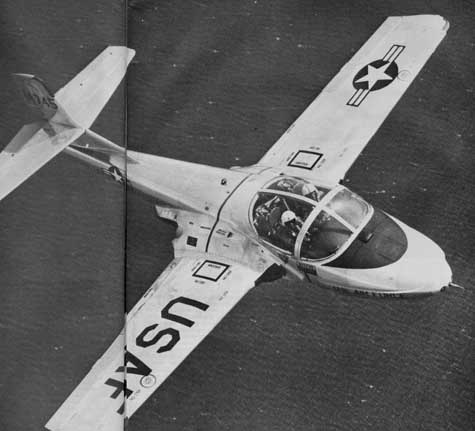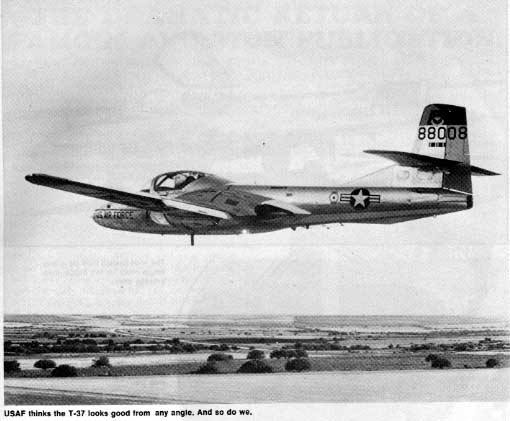

Sitting in it, the feeling of spaciousness and visibility is something you won't find in any civilian two-place ship. The pilots are at least ten inches apart and the sidewalls that much again from your shoulders. With your head clearing the top of the canopy by a sizable margin you still stick out of the airplane from well below your chest up. The instrument panel and consoles are so low that you aren't even aware they are there. It's as if you are sitting on the airplane rather than in it. But all that frontal area has to do bad things to speed. Still, it's a very comfortable environment for a kid to first find out how to play jet jockey. There are two sets of throttles, both set up for left hand operation. The inside throttle on each set has two switches just under your thumb. The top one is for speed brakes and the lower one for communication. The speed brake is a little slat that sticks out from under the nose behind the nose wheel. It is always deployed when coming in for a landing. In addition, thrust attenuators, consisting of hinged flat plates the size of your hand, stick out into the nozzle of each engine. Centrifugal flow engines have extremely long spool-up times, as long as ten seconds from idle to full thrust, but with the attenuators, the power can be left fairly high with the plates deflecting thrust out to the side. The attenuators on the -37 work in conjunction with the spoilers. So, if the spoiler is out, the attenuators are too. However, if you lose an engine and move one throttle to the "cutoff" position and jam the other forward, the attenuators automatically snap out of the way. Ron motioned to me and I leaned over and pulled the safety pins out of the ejection handles on the seat, crossing my fingers as I did. It's just not comfortable knowing you've got your butt wedged into the muzzle of a cannon that's ready to blow you into orbit at a second's notice. It's especially disquieting to know that if it goes off on the ground, it blows you just high enough to kill you when you come down. You have to have something like 100 feet altitude to eject and survive. None of this fancy zero--zero stuff. Starting is a simple matter of hitting the master, moving the start switch for one engine up, hitting the ignition at 5% rpm, turning the ignition off when a rapid rise in EGT is noted and dis-engaging the starter at 25% rpm. With the canopy open, there's no doubt when an engine is running because the scream weasels in through the earmuffs or helmet and tucks your ear lobes into your ears. It takes a healthy poke on the throttle to get the little bird moving, but then even idle thrust will force you to stab the brakes now and then. The nosewheel is only steerable when you depress a switch on the bottom left side of the stick grip, but it's usually easier to use the toe brakes for steering. Besides the usual run-up items, the USAF has other little goodies to check on the -37. For instance, below 10,000 feet a lanyard is hooked directly to the ripcord of your chute for instant opening. Also, you have to follow very strict instructions in the handbook about calculating the nosewheel liftoff speed in a crosswind. Apparently this is pretty important because the tower gave us the lift-off number when we contacted them for takeoff clearance. Normally the nose comes up at about 65 knots but it can go as high as 100 knots in a high crosswind. Elbows in, canopy down, nosewheel button depressed, it was time to go flying. Moving the throttles forward did nothing at first but increase the noise enough to register on the Richter Scale. Then we started rolling. I had expected the acceleration to be almost nonexistent so I was slightly surprised to find myself being gently pushed back in the seat. Even so, the lAS needle wasn't exactly a blur as it edged towards 65 knots. A slight tug on the stick brought the nose wheel off and the "Tweet" ran on its hind legs for a while. When it felt like flying, it did so with absolutely no encouragement from the cockpit. At 100 KIAS I flicked the gear up and got the flaps in at 110 knots. Both of these speeds are specifically stated in the ops manual and you aren't supposed to activate anything slower than that. During the entire takeoff sequence, the effect is one of watching someone else do it on television. The helmet and visor formed a framework around my vision which worked with the expansive cockpit and canopy to create an illusion of flying a simulator. The controls moved in my nomex gloved hand just like they should. The needles on the panel rotated into their preordained niches. The runway rushed past in a proper manner, falling away when the stick moved. But I somehow felt isolated from it, as if the airplane was standing still and everything else was moving. We needed 125 knots for a maximum climb in case one engine shut down (it will safely accelerate to 125 KIAS from around 100 knots with only one engine) so we kept the nose down for a second. Climb speed was about 180 knots and we started threading our way through the clouds at a climb rate of something over 3,000 fpm. Passing through 10,000 feet we had to disconnect the ripoord lanyard (the automatic sequencer would open the chute) and in about six minutes from brake release we were at 15,000 ft., ready to play.

I've flown only one other jet, a Navy A-4, and that was a truly humbling experience. The A-4 was about as much like the airplanes I fly as a 427 Cobra is like my VW. The change was incredible. The T-37, on the other hand, from the instant it took to the air felt just like an airplane. Other than the fact that we were climbing at a speed that was 10 mph higher than the redline on my own airplane, there was nothing really unusual about it. It responds and moves and feels exactly the way you'd want an airplane to. In normal flight there is nothing about it that throws you into fits of either panic or exhilaration. It feels sort of comfortable, like an oldfriend or a well worn pair of boots. More importantly, I think it will light a giant fire under a student's enthusiasm but still not be too much airplane for him to learn to handle. |